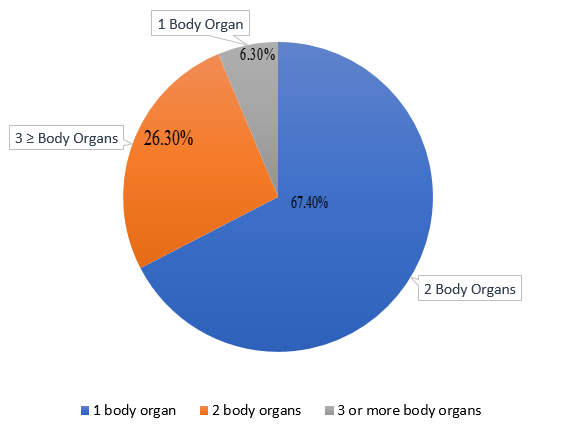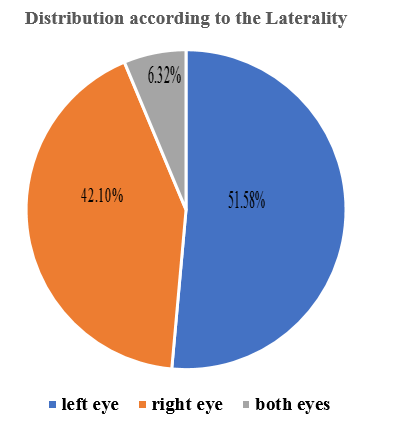Introduction
Road traffic accidents (RTA) have been recognized as a major public health problem, causing high rates of mortality and morbidity. RTA is ranked eighth most common cause of death worldwide.1 India accounts for almost 11% of the accident related deaths in the world.2 In India number of RTA cases are increasing day by day due to the growing number of vehicles, new untrained drivers, congested and poor quality of roads and non-compliance to traffic rules. Road traffic accidents are responsible for a significant number of ocular injuries.3 Though ocular injuries sustained in road traffic accidents are quite diverse, but are often associated with severe vision threatening complications. RTA related severe ocular trauma has significant impact on the individual, their family and society in terms of socioeconomic cost, morbidities, unnecessary toll on medical care, long term disability, loss of productivity, thereby affecting the quality of life. 3, 4 Permanent physical disfigurement and visual impairment can cause negative impact on physical as well as mental health of the victim. RTA is the most common cause of polytrauma and head, face and limbs are most frequently injured body parts. Orbit and maxilla are the most frequently fractured facial bones.5, 6 The common vision threatening complications in RTA related ocular trauma is multiple complex orbital bone fractures, ruptured globe, intraocular haemorrhages, retinal detachment and optic nerve trauma, etc. Computed tomography scan (CT Scan) of face, orbit and skull with 3-dimensional reconstructed imaging is quite helpful in diagnosis and decision making.7 It has been reported that about 90% of ocular trauma are preventable with the appropriate use of protective gear like safety glasses, helmet, seatbelt etc.8 Lack of awareness of preventive measures and delay in immediate medical care, increases the chance of complications and subsequent visual disability and blindness.9 Thus prevention should form the basis of management of ocular trauma. In order to formulate the preventive strategies, current clinico-epidemiological data related to ocular injuries caused by RTA is required. To date, no study has been reported from developing countries where the independent impact of characteristics of vehicle occupants and mode by accident on the RTA related eye injuries have been studied. Hence this hospital based study was conducted to evaluate the epidemiology, clinico-radiological pattern and visual outcome in patients having ocular injuries in road traffic accidents.
Materials and Methods
This was a prospective; hospital based, observational study conducted over a period of 5 years from March 2012 to February 2016 at SS hospital, Institute of Medical Sciences, Banaras Hindu University, Varanasi, Uttar Pradesh, India. The study samples were collected from Trauma center, Ophthalmology and emergency outpatient department of the SS hospital after obtaining the ethics clearance from the research ethical committee of Institute of Medical Sciences, Banaras Hindu University. Patients of all age groups, both sexes having a road traffic accident related ocular trauma and giving consent were included in the study. Patients with ocular trauma >1 month, surgically treated elsewhere, having trauma other than RTA or those having co-existing vision threatening ocular diseases and those refused to participate were excluded from the study.
A prior informed consent was obtained from all the participants before enrollment. Meticulous history and thorough examination of all patients was done and the data were recorded in a predesigned, pretested proforma including demographic variables (age, sex, religion, residential area, marital status, occupation, per capita income, educational status of patients/parents), specific history of trauma (date, time, place and seasonal predilection of injury), type of road user(pedestrian or cyclist or two wheeler bike rider or car or bus occupant), type of road where accident occurred (pitch road or highway or mud road or brick road, etc.), number of vehicles involved, fate of the vehicle(overturned or skidded or run in a ditch or dashed against other objects like tree or wall or pole or other vehicles etc.), mode of injury (projectile object, fall, direct impact like frontal impact or sideways impact), the person’s cognitive state at the time of injury (drunken and sleepy) and information about the use of protective measures (seat belt/helmet etc.) at the time of injury were also noted. Patients were asked about initial complaints, present complaints, time elapsed between injury and treatment/consultation from outside and referral pattern. Patients were directly interviewed by the ophthalmologic team for specific ophthalmic treatment/surgery or admitted by other departmental staff and the ophthalmologic team was consulted. The patients were examined thoroughly to note the number of body parts involved, initial bed side visual acuity, severity of injury, extent of ocular injury (anterior segment/posterior segment involvement, type of globe injury & adnexal injury). Radiological investigations like USG B-scan & CT scan was done as per requirement. The patients were evaluated in deciding the treatment options and prognosis of globe injury was assessed by measuring ocular trauma score (OTS).
The collected data was entered into a spreadsheet and statistical analysis was performed using IBM SPSS (version 17.0 Chicago, USA: SPSS Inc). Categorical numerical variables were analyzed as frequency and percentage and chi-square test of significance was applied. P value <0.05 was considered as significant.
Results
Demographic profile and patient’s characteristics
Out of 402 ocular trauma cases during the study period, ninety-five patients (23.63%) injured due to RTA were included in the study. A total of 84(88.40%) patients were males and 11(11.60%) patients were females (p<0.01) which yielded a male to female ratio of 7.6:1, age ranged from 1 year to 67 years, with a mean and standard deviation of 30.53
Table 1
Demographic characteristics of victims
The majority of patients belonged to Hindu community (81.1%) and married (68.42%). Maximum number of victims belonged to rural background (42.10%) followed by semi urban (31.58%) and urban (26.32%) background. The majority of study subjects were either illiterate (33.68%) or having primary education (29.47%) only. Almost 52.63% victims were unemployed. Fifty one (53.68%) victims belonged to middle and lower middle socioeconomic status and 18.95% belonged to lower socioeconomic status (Table 1).
Injury profile
Table 2 presents the information about circumstances of injury, conditions of roads, vehicles and victims during accidents. Most of the road accidents occurred in the summer (47.37%) season followed by winter (31.58%) and rainy (21.05%) seasons. The majority of the victims sustained injury in the afternoon period between 12.00 -17.59 hrs (29.47%) followed by in evening hours between 18.00-23.59 hrs (27.33%), in late night between 00:00 to 5:59 hours (22.11%) and in morning between 6:00 to 11:59 hours (21.05%). Commonest place of the accident was highway (43.16%) and pitch road (33.68%). However, in 12.63% cases accident occurred at poor quality mud/ kacchi roads in rural area. With regard to mode of travel during RTA is concerned, two wheeler riders (30.53%) are more prone for ocular injuries than those travelling in an auto-rikshaw (5.26%), four wheeler/car (21.05%) or pedestrians (13.68%). However, 29.47% of victims sustained ocular trauma while travelling through heavy vehicles like bus and truck. In the majority of cases (51.58%) vehicles dashed against other stationary objects like tree, mile post, pole, wall and another vehicle. Other fates of vehicle during RTA were swerved (15.79%), run in the ditch (13.68%) and skidded in 10.53% cases. The most common mode of oculofacial trauma was frontal impact (37.89%) followed by sideway impact (26.32%). In 6.32% victims, mode of ocular injury was projectile object while in 29.47% cases it was indeterminate. Alcohol influence was present in 42.11% of the vehicle drivers who sustained ocular injuries. The majority (57.89%) of victims were not using any protective device like helmet/seat belts at the time of injury. About 21.05% patients were sleepy during trauma.
Table 2
Distribution of study subjects according to circumstances of injury, occupant, vehicle and characteristics of collision
Clinical profile
Figure 1 shows only 6.30% injury victims had isolated ocular trauma and rest (93.70%) had polytrauma. Among them majority (67.40%) had two body organ involvement and 26.30% had ≥ 3 body organ involvement. Common multiple organ involvement were maxillofacial and eye injury (49.50%), head and eye injury (18.81%). Out of 95 RTA patients 89(93.68%) had unilateral involvement and rest 6(6.32%) had bilateral eye injuries. There was a predominance of left eye (51.58%) involvement (Figure 2).
In the present study 101 eyes of 95 patients had RTA related ocular injury. Among them, most common ocular part involved was eyelid/periocular skin (85.15% eyes) followed by conjunctiva (82.18% eyes), eye ball in 68(71.58% eyes) and orbit in 51.49% eyes (Table 3).
Table 3
Distribution according to ocular structure involved (N=101 eye)
Table 4 presents type of eyeball injury. Out of total 101 injured eyes, 36 (35.64%) eyes had an open globe injury and 32(31.68%) eyes had closed globe injury. The most common type of open globe injury were ruptured globe (21.78% eyes) and majority of open globe injury belonged to zone II (14.84% eyes) and zone III (10.89% eyes) injury. Among the closed globe injury maximum eyes belonged to zone I (9.90%) and zone II (15.84%) injury).
Table 4
Types of globe injury
Type of ocular injuries in study subjects is given in Table 5. Commonest type of ocular injury was ecchymosis (77.23% eyes) followed by eyelid & periocular laceration (67.33% eyes), globe injury (67.33% eyes), sub-conjunctival haemorrhage (59.41% eyes), orbital fracture (51.49 % eyes), hyphema (41.58% eyes) and lens injury (31.68% eyes) (Figure 3). Commonest posterior segment injury was vitreous haemorrhage (24.70% eyes) followed by retinal detachment (15,84% eyes) and traumatic optic neuropathy (5.94% eyes).
Table 5
Types of ocular injury
Figure 3
Clinical photographs of patients having road traffic accidents with different clinical signs of oculofacial injuries; (A): Showing Right side eyelid and periocular laceration; (B): Showing bilateral ecchymosis, right sided facial asymmetry and abrasion of right side forehead & periocular skin; (C): Showing bilateral ecchymosis and epistaxis; (D): Showing bilateral ecchymosis, facial asymmetry and epistaxis; (E): showing left sided ecchymosis, facial asymmetry and abrasion of forehead & periocular area; (F): Showing right sided bone deep laceration of scalp & partial laceration of eyelids.
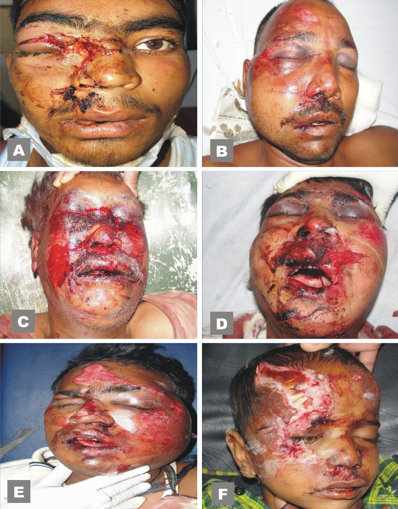
Table 6 depicts the distribution of study subjects according to type of orbital fracture. Out of 52(51.49%) eyes having orbital fracture, 42.31% was associated with maxillofacial fracture, 19.23% had acranio-orbital fracture and 25.00% eyes were having cranio-orbitofacial trauma. However 13.40% eyes had isolated orbital wall fracture.5.26% victims had bilateral orbital fracture. Most of the injured eyes had three orbital wall fracture (38.46%) and two orbital wall fracture (28.85%) while 19.23% eyes had a single orbital wall fracture and 13.46% had pan-orbital wall fracture (Figure 4). Most common orbital wall fracture was floor fracture (34.61% eyes) followed by fracture medial wall (30.77% eyes) and fracture roof of orbit (23.08%). However, fracture lateral orbital wall was only seen in 11.84% eyes.
Table 6
Distribution according to orbital fracture (N=52 eyes)
Figure 4
Coronal and direct frontal 3D volume rendered CT image projection with bonethresholding and coronal reconstruction; (A): showing linear, displaced fracture of left frontal bone involving roof of left orbit; (B): showing comminuted, displaced fracture of mandible, left zygomatic, frontal, maxillary bone involving lateral wall and floor of orbit; (C): showing comminuted, displaced fracture of nasal and ethmoid bone involving both medial orbital wall and fracture right maxilla involving right floor of orbit and fracture left zygomatic bone involving left lateral orbital wall; (D): showing multiple ,comminuted, displaced fracture of left zygomatic, frontal and maxillary bone involving left floor, lateral wall and roof of the orbit; (E): showing multiple displaced fracture of right zygomatic and maxillary bone involving right floor and lateral orbital wall; (F): showing complex comminuted fracture of bilateral frontal bones extending to involve the maxillary, zygomatic, nasal and ethmoid bones.
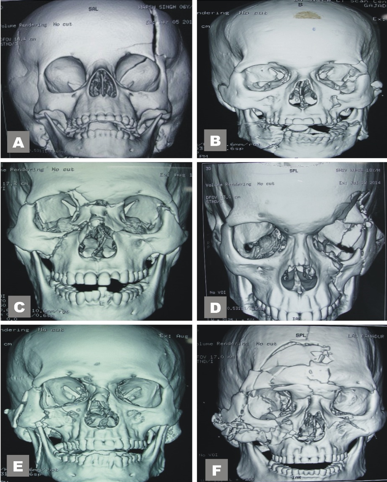
The majority of patients (83.16%) required multidisciplinary treatment, however 16.84% patients treated by only ophthalmic surgeon. 8.4% patients underwent multiple ocular surgeries (Figure 5, Figure 6).
Figure 5
(A): A case of road traffic accident with deep laceration of left side forehead and medial canthal area with oedema of left eyelid, periocular area; (B): Coronal and direct frontal 3D volume rendered CT image projection with bone thresholding and coronal reconstruction showing complex comminuted, displaced fracture of left frontal and nasal bone involving left roof of orbit with linear fracture of left frontal process of zygomatic bone; (C): axial bone widow image showing proptosis and soft tissue swelling of left orbit with fracture zygomatic process; (D): Clinical photograph of patient after multidisciplinary operative treatment showing marked
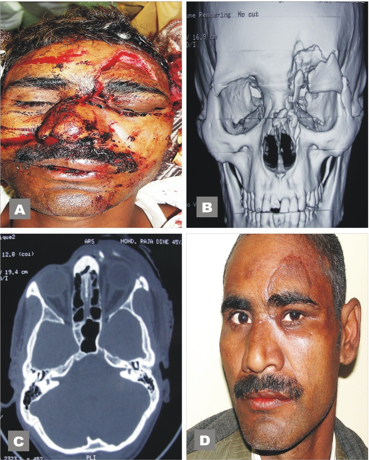
Upon initial presentation 40 eyes (39.60%) had visual impairment (VA<6/18-6/60) and 22 eyes (21.78%) had blindness (VA<6/60-NO PL) while the visual acuity could not be assessed in 12(11.88%) eyes. On final follow up, the number of visually impaired eyes fell down to 31(30.69%) and blinding outcome was found in 26(25.74%) eyes [Table 7]. Visual outcome was directly proportional to the number of orbital wall fracture. Severe visual loss was observed in eyes having ≥2 orbital wall fracture [Table 8].
Table 7
Initial and Final Visual Acuity(N=101 eyes)
|
Visual Acuity |
Initial |
Final |
||
|
|
No |
Percentage |
No |
Percentage |
|
6/6 -6/18 |
27 |
26.73 |
30 |
29.70 |
|
<6/18-6/60 |
40 |
39.60 |
31 |
30.69 |
|
< 6/60-NPL |
22 |
21.78 |
26 |
25.74 |
|
Unknown |
12 |
11.88 |
14 |
13.86 |
Table 8
Visual Acuity according to no of orbital wall factor (n=52 eyes)
Figure 6
(A & B): A case of road traffic accident with deep laceration and avulsion of about medial half of the left eyelid with rupture of left globe; (C): axial bone widow image showing disorganized left globe with orbital oedema; (D): Showing surgical enucleation and repair of eyelid laceration: (E): Post operative photograph of patient showing good eyelid restoration and phthisic eye; (F): photograph of patient after putting artificial eye.
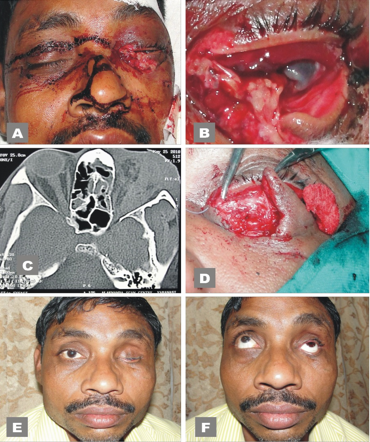
Discussion
Road Traffic Accidents (RTA) a major cause of vision loss in young adult population. Ocular trauma due to RTA is common in both developed and developing countries with different risk factors. Factors responsible for RTA related ocular injuries include human factors (like age, sex, physical impairment, alcohol or any drug intoxication while driving, etc), environmental factors (like season and weather conditions), time of injury (night driving), condition of the road, vehicle factors (like the type of vehicle, speed of vehicle, safety design of the vehicle) and mode by accident etc.
In this Hospital based observation study, Out of 402 ocular trauma patients, 95 patients (23.63%) were injured due to RTA. The variable incidence of RTA related ocular injuries have been reported in previous studies, like Canavam et al10 (32.5%), Georgouli et al11 (56%), Mackay et al12 (70%), Laila et al13 (60.7%) and El Shtewi M, et al14 (12.5%). It has been reported that young adult males have a high risk of ocular injury in an RTA.
In this study, male patients (88.40%) had more ocular injuries as compared to females (11.6%) with M:F ratio being 7.6:1. Other researchers also reported a male predominance like El Shtewi M, et al14 from Libya reported 75% male and 25% female injury victims, Jonston et al15 from Northern Ireland reported RTA related ocular injuries in 72.20% of his male patients and 27.20% of his female patients, and Kumar J, et al16 from India reported incidence as 77.6%in males and 22.4% in females, Arora et al17 from India also reported M: F ratio to be 2.5:1. This higher incidence of ocular trauma in an RTA in men can be explained by their more outdoor activities with increased travelling and rash driving.
In our study, the most vulnerable age group was between 21-30 years (25.3%) followed by 31-40 years age group (24.2%) and 11-20 years (21.1%). Similar peak age of 21-30 years were also reported by Alam J, et al18 from India. Ezegwvi et al19 and Arora et al have also reported similar peak age (16-30years) in their study. However Muralidhar et al20 reported higher peak age (41-50 years) than that reported in most of literature and they gave an explanation saying that in South India even elderly persons are also bread winners of the family. This is obvious from the present study that vulnerability in ocular trauma is more common in young adults and productive age group and this decreased in extreme, dependent age group.
In this study, we observed that the incidence of RTA related ocular trauma was higher in summer season (47.37%) than in the winter season (31.58%) and rainy season (21.05%) showing seasonal trends in the occurrence of RTA. In India summer season is a season of marriage and school holidays and more people travelling on the road. In winter, season, cold and foggy climate limits the close visibility and may cause vehicular collision. In such climate, vehicles with fog lamp and slow speed can minimize the accident. Maximum RTA occurred on a week-ends and during afternoon (29.47%) and in the night time. The afternoon is the time for outdoor activity and productive hours of every individual and during the night most of the drivers facing difficulties in driving due to glare caused by headlights, and also complain fatigue and sleepiness.
In this study, it is observed that two-wheeler riders (30.53%) were more prone to ocular injuries than three-wheeler riders (5.26%), car-occupants (21.05%) and pedestrian (13.68%). However Madhuramuthu et al21 from India reported that 87.33% and Kumar J et al16 reported that 73.6% of ocular injuries occurred in two-wheeler riders. The majority of accidents occurred either on the highways or on the pitch road. In most of the accident cases, a vehicle crashed against other stationary objects like a tree, pole or another vehicle. The commonest mode of injury was a frontal collision (37.89%) followed by sideways impact (26.32%). In car occupants, driver and who rode on the left front seat sustained severe ocular injuries than those who rode with a middle seat.
In this study, it is also seen that 53.89% of two-wheeler riders were not wearing helmet and none of the car occupants were wearing seatbelt while riding. It has been reported that after compulsory seatbelt wearing legislation was introduced in car driving, a 60-75% reduction in RTA related ocular injuries was observed.22 Thus travelling without wearing protective gears (helmet and seat-belts) is one of the major modifiable risk factors for RTA related ocular injuries.
In our study, driving under the influence of alcohol was noticed in 42.10 % of drivers. Similar observations were also reported by Alam J, et al.18 However, Kumar J et al16 reported that 71.2% of drivers who sustained ocular injuries were under the influence of alcohol while driving. Thus driving under the influence of alcohol is another risk factor for RTA related ocular injuries.
RTA related eye injuries are frequently associated with polytrauma. In this study only 6.30% injury victims had isolated ocular trauma rest had multiple organ involvement. Commonest involved organs were face and skull. Majority (93.68%) of the victims had unilateral ocular involvement. The reported incidence of bilateral ocular involvement among RTA related ocular injuries varies from 4% to 50%; Briner et al23 (4%), Kriedl et al24 (4.9%), Kumarasamy et al25 (9.7%), Taylor et al26 (50%). In this study there was a slight predominance of left eye (51.58%) involved. However, previous studies reported higher proportion of right eye injury.14, 17, 20, 25, 27 The important prognostic factors of an eye injury are ocular tissue involvement. The posterior segment injury has a worse prognosis than trauma confined to the anterior segment. Out of 101 eyes, orbital injury was seen in 51.49% eyes. Eyelids were involved in 85.15% eyes, conjunctiva in 82.18% eyes and globe injury in 67.33% eyes. The posterior segment injury was noticed in 52.48% eyes. Similar finding was reported by Kumarsamy et al.25 In our study, commonest ocular injury was ecchymoses (77.23% eyes) followed by eyelid laceration (67.33%), subconjunctival haemorrhage (51.41% eyes) and globe injury (67.33%). KumarJ et al16 reported periorbital oedema with ecchymoses (82.2%) followed by eyelid laceration (68.8%) as a commonest type of injury. Similar findings were also reported by Alam J et al18 and Kumarsamy et al.25 The commonest ocular injury reported by Muralidhar et al 20 was subconjunctival haemorrhage followed by ecchymoses. Orbit and periocular structures are the first structures to take impact of the injury in accident.
Open globe injury specially rupture globe is one of the major risk factors for poor visual outcome because it always requires surgeries which may be difficult and may lead to long term visual impairment.28, 29 In our study open globe injury (35.64%) was more common than closed globe injury (3168%). While other studies reported high incidence of closed globe injury in RTA; Mishra A et al30 (86.4%), Marudhamuthu et al21 (95.34%), Smith et al31 (68.58%) and Kumarsamy et al25 (95.13%). In this study, the commonest type of open globe injury was a rupture globe in 21.78% eyes and rest 13.86% eyes had penetrating injury leading to corneoscleral laceration. Majority of open globe injury fell in zone II (11.18% eyes) and zone III (19.8% eyes) injuries. Various studies have demonstrated that zone II and zone III injuries are risk factors likely to predict poor visual prognosis.32, 33, 34
In our study 52 eyes of 48 (50.53%) patients had orbital fractures. Cruz et al 35 reported RTA related orbital fractures in 54% of patients and Kumarsamy et al 25 found orbital fractures in 22.22% of study subjects. While in study of Shtewi et al 14 only 1.1% of victims presented with orbital fracture. The isolated orbital fracture was seen in 13.46% cases only and rest of the patients had associated fractures of facial and cranial bones. Most of the injured eyes had three orbital wall (38.46%) and two orbital wall fractures (28.85%) while 13.46% eyes had pan orbital wall fractures. In our study, inferior wall (34.61% eyes) and medial wall (30.77%) fractures were more common. Least commonly fractured orbital wall was lateral wall (6/52, 11.54% eyes) because the lateral wall is strongest orbital wall. However, in study of Marudhamuthu et al,21 the lateral wall fracture was common (8 out of 14 orbital fracture cases). His explanation being the major force coming from the sideways impact in an RTA. In this study, about 50% of patients having rupture globe had associated multiple orbital wall fractures. In the study done by Chen X et al,36 out of 197 eyes of a rupture globe, 32 eyes got injured due to RTA. Among them 15 eyes had rupture globe with orbital fracture. In the present study 4.22% of patients with rupture globe required enucleation. While previous studies showed that 5-23% of open globe injury patients required excision of globe.5, 15, 37 In road traffic accident case, orbital fracture may lead to severe loss of vision.38
In our study, 29.70% eyes had good visual outcome and 30.69% eyes had visual impairment. However, blinding outcome was found in 25.74% eyes. Visual outcome was directly proportional to the number of orbital walls fractured. We noticed that blinding outcome was maximum in eyes having more than 2 orbital wall fracture. Above findings suggested that orbital fracture could be an independent risk factor for poor prognosis in RTA related eye injuries. Above findings also explained that ruptured globe with orbital fractures is a severe type of eye injury that may carry a worse prognosis.
Few limitations of our study should be acknowledged and discussed. First, as it is a hospital based study, therefore trends cannot be stipulated directly to the community and a nationwide eye injury surveillance system should be established. Second being relatively small size for internal subgroup comparison. Another limitation of this study is being whether delayed presentation is related to visual outcome or not was not assessed. However, these limitations do not significantly affect the major findings of this study.
Conclusion
In conclusion, RTA can cause severe ocular trauma. Victims are usually adult males of the productive age group. Two wheeler riders, frontal impact, alcohol consumption, non use of safety measures and not following traffic rules are major risk factors. We found several other prognostic factors for poor visual outcome; ruptured globe with zone II or III injury, multiple orbital fractures, intraocular haemorrhage and posterior segment trauma, poor initial visual acuity. Public health education regarding use of helmet & seat belt, early reporting and appropriate intervention may reduce the vision threatening complications & blindness in RTA related ocular trauma.

